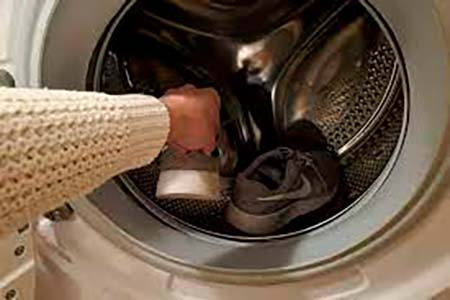Drying shoes in a dryer can be a convenient way to ensure your favorite pair is ready to wear, especially during wet seasons. However, it’s essential to know how to do it safely and effectively to avoid damaging your footwear and potentially compromising your dryer’s performance. In this guide, we will explore the dos and don’ts of drying shoes in a dryer and offer tips to help you keep your shoes in great condition.

Potential Damage to Shoes
When it comes to drying shoes in a dryer, potential damage to your beloved footwear is a significant concern. Excessive heat is a primary culprit that can cause various types of damage:
- Warped Soles: The intense heat inside the dryer can warp the soles of your shoes, altering their shape and structure.
- Shrinkage: Some shoe materials, such as certain types of leather or synthetic blends, may shrink when exposed to high temperatures, resulting in shoes that no longer fit comfortably.
- Cracking: Excessive heat can cause the materials in your shoes to become brittle and crack, leading to irreparable damage.
- Misshapen Shoes: Inappropriate tumbling can lead to misshapen shoes. The force of the dryer’s motion can bend and twist your shoes, altering their original form.
- Detached Soles: For shoes with glued soles, the heat and tumbling can weaken the adhesive, causing the soles to detach.
When Is It Safe to Dry Shoes in a Dryer?
Not all shoes are suitable for drying in a dryer. Knowing when it’s safe to do so is critical to prevent damage.
Material Considerations
Different shoe materials react differently to heat and tumbling. While some shoes can handle the dryer’s conditions, others cannot. Here’s a breakdown of materials and their dryer-friendliness:
- Canvas: Canvas shoes are generally safe to dry in a dryer. However, it’s crucial to use a low heat setting to prevent any damage.
- Synthetic Materials: Shoes made from synthetic materials like polyester or nylon are often dryer-safe. Again, opt for low heat to avoid melting or warping.
- Leather: Genuine leather shoes are not suitable for dryer drying. High heat can cause leather to crack, shrink, or lose its natural oils. Air drying is the best choice for leather.
- Suede and Nubuck: These delicate materials are highly susceptible to damage from both heat and moisture. Never use a dryer for suede or nubuck shoes; it can ruin the texture and appearance.
- Rubber and Plastic: Shoes with rubber or plastic components, like some rain boots or sports shoes, can be safely dried in a dryer. Ensure a low heat setting to prevent melting.
- Mesh or Knit Fabrics: Shoes with mesh or knit uppers can be dried in a dryer, but it’s essential to use a gentle, low-heat cycle to prevent damage to the fabric.
Shoe Type Matters

Beyond material considerations, the type of shoe you’re drying also matters. Here’s a quick overview of shoe types and their suitability for dryer drying:
- Sports Shoes: Running shoes, sneakers, and athletic footwear are often dryer-safe, especially if they have rubber or plastic components. Always use a low heat setting.
- Casual Shoes: Everyday shoes made of canvas or synthetic materials can generally be dried in a dryer with caution.
- Delicate Dress Shoes: Leather or suede dress shoes should never go in a dryer. Air drying is the best option for preserving their quality.
- Boots: Depending on the material, boots can be suitable for dryer drying. Rubber or plastic rain boots can handle it, but leather boots should not be dried in a dryer.
- Sandals: Open-toed shoes with minimal fabric or leather can often be dried in a dryer using a gentle setting.
Preparing Your Shoes for the Dryer
To ensure safe and effective drying, proper preparation of your shoes is essential. Follow these steps before placing your shoes in the dryer:
Removing Loose Debris
- Before tossing your shoes into the dryer, take a moment to remove any loose dirt, mud, or debris from the soles and interiors. This simple step not only prevents damage to the dryer’s interior but also ensures your shoes dry more efficiently.
Fastening Shoe Components
- Secure laces, straps, and any removable components of your shoes. By doing so, you can prevent tangling or damage during the drying cycle. Fastening these elements ensures that they remain in good condition, and your shoes come out of the dryer intact.
Cleaning if Necessary
- If your shoes are particularly dirty or have stubborn stains, consider giving them a quick clean before placing them in the dryer. Cleaning your shoes beforehand not only prevents any dirt from spreading inside the dryer but also ensures that your shoes come out looking their best after the drying process.
Using a Shoe Bag
- For an added layer of protection, think about using a shoe bag or a specialized laundry bag designed for shoes. These bags help contain your shoes, preventing them from tumbling freely and potentially causing damage to the dryer drum or other clothes. Additionally, using a shoe bag can reduce noise during the drying cycle.
Adding Dry Towels
- To enhance the drying process and reduce noise, include a few dry towels in the dryer along with your shoes. The towels will help absorb moisture and prevent excessive banging or thumping sounds during the drying cycle.
Selecting the Appropriate Dryer Settings
- Choosing the right dryer settings is crucial to safely and effectively dry your shoes. Here’s how to select the appropriate settings:
Low Heat or Air Fluff Setting
- Always use the lowest heat setting available, typically labeled as “Low Heat” or “Air Fluff,” when drying shoes in a dryer. High heat can damage the materials in your shoes, causing warping, shrinking, or even melting. The low heat setting provides a gentle, controlled drying process that minimizes these risks.
Shortened Drying Cycle
- Opt for a shorter drying cycle to minimize drying time. Longer cycles can subject your shoes to unnecessary wear and heat. Most dryers offer various cycle lengths, so choose the one that corresponds to your shoes’ needs.
Periodic Checking
- During the drying cycle, periodically check your shoes for dryness. Drying time may vary depending on the materials and level of saturation. Remove your shoes from the dryer once they are completely dry to prevent any additional heat exposure.
Use Dry Towels
- To further protect your shoes and reduce noise during drying, include a few dry towels in the dryer with them. Towels serve multiple purposes: they help absorb moisture from the shoes, protect the dryer’s interior from potential scuffing, and reduce the impact noise created by the shoes tumbling.
Prevent Wrinkling
- To prevent your shoes from becoming misshapen during the drying process, use dryer balls or clean tennis balls. Place these items inside your shoes before putting them in the dryer. These balls help maintain the shape of your shoes and prevent them from wrinkling or collapsing.
Air Drying as a Safer Alternative
- If you have any doubts about using a dryer for your shoes, the safest alternative is air drying. Find a well-ventilated area, place your shoes in a way that helps them maintain their shape (such as stuffing them with newspaper), and allow them to dry naturally.